 By definition, to unify means to “make or become united, uniform or whole.” But for many modern businesses, there seems to be a “whole” lot more division than holistic cohesion.
By definition, to unify means to “make or become united, uniform or whole.” But for many modern businesses, there seems to be a “whole” lot more division than holistic cohesion.
Not only is there often a clear separation between departments, such as the gap between sales and marketing, but within each department, many processes can also feel disjointed— and each side’s goals very different.
Internal team members often act like single pawns on the chessboard of life, making moves without any real coordination between their teammates, never mind other departments.
Businesses strive to align their sales and marketing teams to land more customers, but more often than not, each side has its own set agenda, and never truly works together.
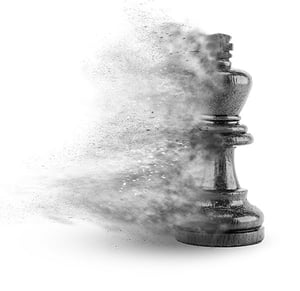 A few decades ago, this was just how it was. Sales and marketing teams could operate independently, fighting to meet their department’s quotas without too much concern for the other side.
A few decades ago, this was just how it was. Sales and marketing teams could operate independently, fighting to meet their department’s quotas without too much concern for the other side.
In recent years, companies began to realize that working separately wasn’t working. The consumer wised up and saw through the inconsistencies in messaging versus sales tactics— and businesses had to get smarter to win their trust. So began the shift to align sales and marketing. Businesses began to make it a requirement for the teams to work together to land the sale, but even today this “alignment” is often met with disdain and resistance, and rarely works as the CEO envisioned.
Companies attempt to unite their departments like the Knight on the chessboard. The team moves in a coordinated direction towards their shared goals.
Except now, there’s one big problem: the chessboard now belongs to the customer— and moving like a Knight is useless.
Customers are now setting the rules of the game and expect a consistent experience, no matter who they’re talking to on your team. Whether they’re in contact with sales, marketing, customer service, IT, etc., misalignment between teams breaks their trust.
Oftentimes, neighboring departments want to provide this seamless experience, but they simply don’t understand the goals and constraints of other internal teams. Yet only when they gain this understanding can the business run as one unified entity.

Now, the old rules of the game are gone. Consumers seized the board and there’s no roadmap to follow.
That means bad news for your Knight.
In Chess, the Knight can only move to designated squares, and without a checkerboard to move along, this isn’t the piece you want your team to be.
Fortunately, for another chess piece, the removal of the board isn’t a threat— it’s an opportunity.
Which piece can move wherever it pleases, without needing to follow a coordinated pattern? To gain back power, your departments must embody one resourceful chess piece, which is capable of moving in any direction.
Your company’s sales and marketing teams must become the Queen.
So far we’ve learned two valuable things:
Becoming a Unified Business is like becoming the Queen.
What does the Queen look like from an aerial view? A circle. This cylindrical concept is key, as it’s a common theme you’ll notice as we define what it means to be a Unified Business.
The Unified Business methodology is a transformative way of streamlining your company, achieved by aligning every department around a shared central goal and continuous strategy for achieving it.
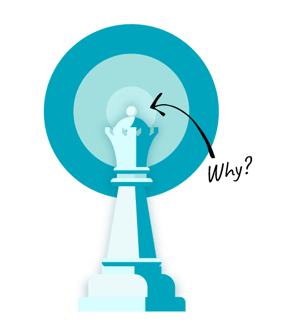 Regardless of whether the journey starts with marketing, sales or customer service, everyone needs a center point to align to— or a shared core. This central point is the foundation for supporting your business, and without it, your Queen can’t stand.
Regardless of whether the journey starts with marketing, sales or customer service, everyone needs a center point to align to— or a shared core. This central point is the foundation for supporting your business, and without it, your Queen can’t stand.
But what lies at the center of your business? A strong grounding, secured by a shared goal. Your core is comprised of your company’s mission and vision, or its sole purpose for existing and is supported by the hands of your employees upholding it.
The problem is, many businesses today don’t have their mission or vision statements clearly defined or have employees who are not aware of these important goals.
How do you know if you have a clear vision? If a stranger were to visit your company and ask each person they meet, "Why does this company exist?" would everyone have a consistent response? If you are not confident that the visitor would get a similar answer from each employee, then focus here first.
It’s unrealistic to ask your teams to collaborate together if they don’t know the grand purpose. How can your employees work together if they can’t agree on what the end-goal should be?
We want to bring the company together as one to deliver a consistent customer experience. That’s why the first step to becoming a Unified Business involves defining your company’s core... by discovering your WHY.
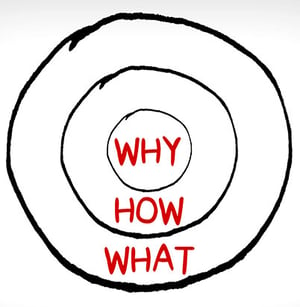 Author and motivational speaker Simon Sinek popularized the concept of what he coined as “The Golden Circle Theory.”
Author and motivational speaker Simon Sinek popularized the concept of what he coined as “The Golden Circle Theory.”
His philosophy states that at the core of any company is its motivation: why the business exists, or its purpose.
This principle operates on one simple notion: people don’t buy what you do, they buy why you do it.
Customers usually aren’t won over by the fancy specs and features of your product or service; they care about why you operate, or the force that drives your business and inspires— or unites your customers in a shared cause.
Do you have a mission and vision statement? Or, are the ones you have outdated or not properly defined? Luckily, we can help.
Outlining your company’s purpose starts with asking yourself why your company does what it does. Here’s a little secret... it’s not to make money. And if it is, if that’s the only reason you open your doors every day, your company is not going to last.
Why will a financially-driven purpose eventually lead to a crash and burn? It’s quite simple. You won’t have your consumer’s trust.
“Trust begins to emerge when we have a sense that another person or organization is driven by things other than their own self-gain,” Simon Sinek explains.
If the consumer can share values with your brand, they can begin to identify and build trust with your business.
Consumers rarely buy a product or choose a service just because they are told the product outperforms a competing item or because the service is exceptionally better. The “best” doesn’t always win; it’s the company that inspires its customers that people come back to time and time again.
Win your customer’s trust by forming a solid mission and vision statement using the following format:
To_____(contribution/verb)_______ so that ______(impact/noun)______.
The first part outlines your mission, while the second half beginning with “so that,” defines your vision.
For example, here at HubDo our mission/vision statement is “to give good business an unfair advantage so that ethical companies support our future.”
We highly recommend reading Find Your Why, for a step-by-step guide on finding and outlining your company’s purpose to begin creating a Unified Business.
 After discovering your WHY, Simon Sinek’s Golden Circle Theory states that the next step is to define HOW you’ll achieve your mission and vision.
After discovering your WHY, Simon Sinek’s Golden Circle Theory states that the next step is to define HOW you’ll achieve your mission and vision.
Following that same vein, we’re now going to talk about how you can use your central core as a compass for becoming a Unified Business.
Once you define your big why, it’s time to get your team working in a unified way to support it.
This unified push in the same direction helps to keep your operations moving forward. We call it your company’s Customer Success Vortex, and it gives your team the momentum it needs to keep turning out business.
Happy customers become the energy that fuels this Vortex— and accelerating your customer success makes it turn faster, i.e. more delighted customers equals a more efficient business.
Here’s how it works: high-retention customers spin to the top of the vortex, exclaiming praise and promoting your brand. These advocates help to feed the life of your company and land you more sales from the top down.
But let’s not get ahead of ourselves. How can you foster loyal evangelists? To create this powerful Vortex of force, you need a T-shaped team all working in unison.
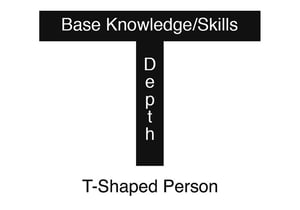 The disconnect between departments is often brought about by a lack of understanding of the other team’s responsibilities.
The disconnect between departments is often brought about by a lack of understanding of the other team’s responsibilities.
Sales and marketing teams are often thought of as different species, living in two completely separate worlds, but that couldn’t be farther from the truth. In fact, sales and marketing are closely related, and all it takes is a little empathy and general knowledge of others’ roles to see that.
That’s why it’s so important to hire or groom a team of T-shaped vs. I-shaped individuals.
A T-shaped person has a deep level of knowledge/skills in one area as well as a broad base of generalized knowledge/skills within related areas to their niche.
A T-shaped individual is educated around more than just their own specialization; they have a wide understanding of supporting skills and roles too.
Unfortunately, many businesses are made up of mostly I-shaped workers, who only have the depth of their concentrated skill— and lack “general” knowledge of the responsibilities and struggles of other departments.
While an entire team of T-shaped workers would be the ultimate goal, it’s more important than ever to choose leaders who can branch out beyond their own expertise.
Not only is it useful for managing over their direct team of diverse positions, but broad, cross-skilled knowledge will also help your leaders to understand the goals, bottlenecks and strengths of other departments— to streamline processes and work cohesively.
For instance, a Sales Manager can benefit from knowing a thing or two about marketing, customer service and even other areas like IT, HR and finance.
You might say, “that sounds nice in theory, but what business has the time to train all their leadership team on every role in the company?” It’s certainly not something that’s going to happen over night, but there are ways you can prime your authority figures with the tools they need to become more T-shaped.
For starters, we recommend a few pivotal books, which pave the way to the shared highway between departments...
There are eight books that can teach almost any leader on your team all they need to know about their neighboring departments.
Here are our recommended readings:
Create a T-shaped team in one quarter by “assigning” these books to your workers.
While reading can take longer, audiobooks are usually quicker to peel through. Most of the challengers we’ve helped completed all eight books within eight to ten weeks— and your team can too.
 Lastly, the final part of the Customer Success Vortex is the outer circle, which covers Sinek’s WHAT or what a Unified Business offers to its consumers. It’s here that we complete the arc of the story and really deliver on the Unified Customer Experience that clients expect.
Lastly, the final part of the Customer Success Vortex is the outer circle, which covers Sinek’s WHAT or what a Unified Business offers to its consumers. It’s here that we complete the arc of the story and really deliver on the Unified Customer Experience that clients expect.
A Unified Business understands the importance of delivering a fantastic product, first and foremost. Before concerning yourself with how you’ll please and delight your customers, you must first design an exceptional product or offer a superiorly performed service.
If someone received a product or service that they aren’t happy with, it doesn’t matter how well you rectify the matter. The damage is done.
Imagine you ordered a new paint brush online to repaint a room in your home. If the brush arrives in pristine packaging, perfectly protected, and the tool works wonderfully, you might hop onto Amazon and leave a great review.
If, however, the product arrives with a few bent bristles, or if they fall out mid-painting, that’s a different story. Regardless of how nicely the team handles the complaint or how quickly they send a replacement brush, your feelings about the company have already been set. You may respect them for how they handled the “fix,” but you will likely not become a promoter of this brand. You won’t tell your friends about this great paint supply company nor feel compelled to leave a stellar review— even if the second brush works just fine.
Delivering an exceptional experience starts the moment you first make contact with the consumer, not just after they receive your product or service.
To learn more about perfecting the customer experience, we suggest reading The Effortless Experience: Conquering the New Battleground for Customer Loyalty by Matthew Dixon.
The gurus at HubSpot also support the idea of a circular journey, explained in the visual representation of a Flywheel.
Whereas a typical sales funnel loses its momentum at the bottom and treats customers as an outcome, a wheel with a solid axle always has a steady accelerant around its core.
For inbound marketers, the customer is always the driving force behind everything: unifying all departments and helping your business grow.
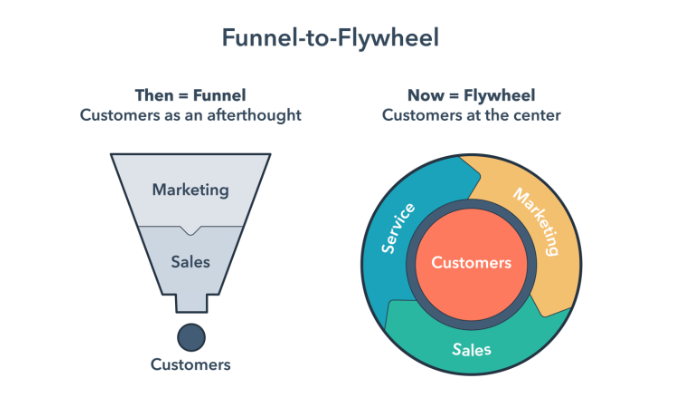
Many adopters have joined HubSpot in ditching the idea of the funnel. Not only do funnels lose all of their momentum at the bottom, but the customers also are treated as an afterthought once they make the purchase.
With a circular-based methodology— such as HubSpot’s Flywheel and our Vortex— the customer experience is an accelerant.
No matter what part of the company the customer touches, including sales, service or marketing, they are a continual part of the journey, long after the initial sale.
But whereas the Flywheel clearly separates each department in its visual, like handing over the baton to the next department, the Unified Business model blends all your company’s teams together.
That’s because no matter who the customer is dealing with, these T-shaped teams can provide the same exceptional experience.
Another way the outer layer of the Customer Success Vortex represents the customer experience is through its friction-free, infinite turning. This highlights the importance of removing all obstacles, such as the separation between teams or a lack of shared purpose, to create a seamless experience for every consumer.
Simon Sinek is known for more than just his Golden Circle Theory. He’s also tackling the subject of infinite vs. finite games, and how they influence businesses today.
In his book, The Infinite Game, Sinek outlines a remarkable concept. He asserts that businesses play two very different games:
So many businesses today strive to be #1, to become the best in their industry. But this is hardly an attainable goal, as there’s no such thing as “winning” in business. Your company will eventually close its doors, it might be 100 years from now, but in the end your business itself doesn’t matter— your legacy is how you earned the right to grow by improving your customer’s lives.
Sinek highlights the importance of supporting your cause and focusing on constant improvement, instead of beating the competition.
A Unified Business is one that is driven by its purpose, participating in the infinite game, in support of never-ending future growth. We highly recommend reading his book or watching his talk and adopting this way of thinking within your business.
To end, we’d like to leave you with this powerful quote:
“Nobody owns the customer, but someone always owns the moment,” said Scott Hudgins, VP of Global Customer Managed Relationships at the Walt Disney Company.
Walt Disney World/Land is one company which embodies the Unified Business methodology. At the parks, it doesn’t matter who you talk to, you always receive the welcome, cheery Disney experience.
That’s because Walt believed in creating a world off of the screen, to bring his animated visions to life beyond the 90-minute full featured movie. He pursued his dream despite many nah-sayers, and sold all his assets from his animations to self-fund his park.
Walt had a just cause and the courage needed to risk it all.
Seize your moment and adopt the Unified Business Experience by discovering your company’s purpose, developing T-shaped leaders and streamlining your processes.
One huge way to eliminate friction within your company and deliver a better customer experience is to also unify your toolset.
In today’s world, companies need mutual access to software and tools to serve their consumers, but integrating these assets can cause a lot of tension and hiccups. Learn more about how HubDo can help to streamline your tools and unify your business’ processes. Using this link you can have a chat with Pete Nicholls, CEO of HubDo, HubSpot Trainer and Mentor